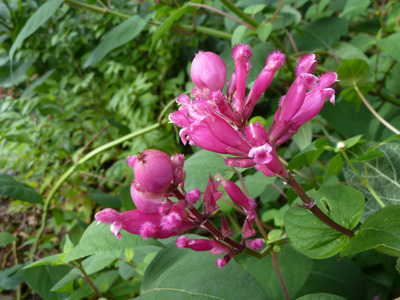Plants of the Week: October 31
 Ajania pacifica, often referred to as the gold and silver chrysanthemum, is a rhizomatous herbaceous perennial native to central Asia. It typically forms a dense, compact 18-24” mound of foliage. Each leaf margin is edged in silver. While Ajanica pacifica is typically grown for its foliage, corymbs of small, button-like yellow flowers appear in autumn. A. pacifica is hardy from zones 5 to 9 and dislikes soils to remain wet throughout the winter. Photo credit: J. Coceano
Ajania pacifica, often referred to as the gold and silver chrysanthemum, is a rhizomatous herbaceous perennial native to central Asia. It typically forms a dense, compact 18-24” mound of foliage. Each leaf margin is edged in silver. While Ajanica pacifica is typically grown for its foliage, corymbs of small, button-like yellow flowers appear in autumn. A. pacifica is hardy from zones 5 to 9 and dislikes soils to remain wet throughout the winter. Photo credit: J. Coceano
 Molinia caerulea ssp. arundinacea ‘Skyracer’ can be seen as a backdrop to the Swarthmore College rock along College Avenue and growing in the Terry Shane Teaching Garden. The perennial clumping grass produces foliage standing 24-36” tall. In midsummer, slender spikes, up to 8’, fountain upright and arch outward. This “see-through” grass provides structure without blocking views. Photo credit: J. Coceano
Molinia caerulea ssp. arundinacea ‘Skyracer’ can be seen as a backdrop to the Swarthmore College rock along College Avenue and growing in the Terry Shane Teaching Garden. The perennial clumping grass produces foliage standing 24-36” tall. In midsummer, slender spikes, up to 8’, fountain upright and arch outward. This “see-through” grass provides structure without blocking views. Photo credit: J. Coceano
 Tilia cordata ‘Winter Orange’ is a distinctive cultivar of the little-leaf linden native throughout Europe. Crisp green leaves turn butter-yellow before dropping. As leaves drop, young twigs turn orange and remain so throughout the winter months. The deciduous tree, up to 60’, creates a rounded crown and tolerates dry soil conditions. Look for the orange stems on a young tree planted near Papazain Hall. Photo credit: J. Coceano
Tilia cordata ‘Winter Orange’ is a distinctive cultivar of the little-leaf linden native throughout Europe. Crisp green leaves turn butter-yellow before dropping. As leaves drop, young twigs turn orange and remain so throughout the winter months. The deciduous tree, up to 60’, creates a rounded crown and tolerates dry soil conditions. Look for the orange stems on a young tree planted near Papazain Hall. Photo credit: J. Coceano
 Salvia involucrata bears masses of rosy magenta tubular flowers above heart-shaped leaves. Flowering begins in mid-summer and carries through to the first hard frost. Hummingbirds find the rosebud salvia irresistible. Treat as a tender perennial or take cuttings in late summer. Photo credit: J. Coceano
Salvia involucrata bears masses of rosy magenta tubular flowers above heart-shaped leaves. Flowering begins in mid-summer and carries through to the first hard frost. Hummingbirds find the rosebud salvia irresistible. Treat as a tender perennial or take cuttings in late summer. Photo credit: J. Coceano





Jay Trolley
Posted at 19:35h, 08 NovemberWould you consider providing a pronunciation guide for the ‘latinized’ name of the plants and trees. It would not require too much space but might help certain readers who are a little challenged!
Becky Robert
Posted at 10:29h, 09 NovemberJay, it was suggested we do a series of posts on latin and nomenclature of plants. We could cover some commonly questioned latin pronunciation in that series as well.